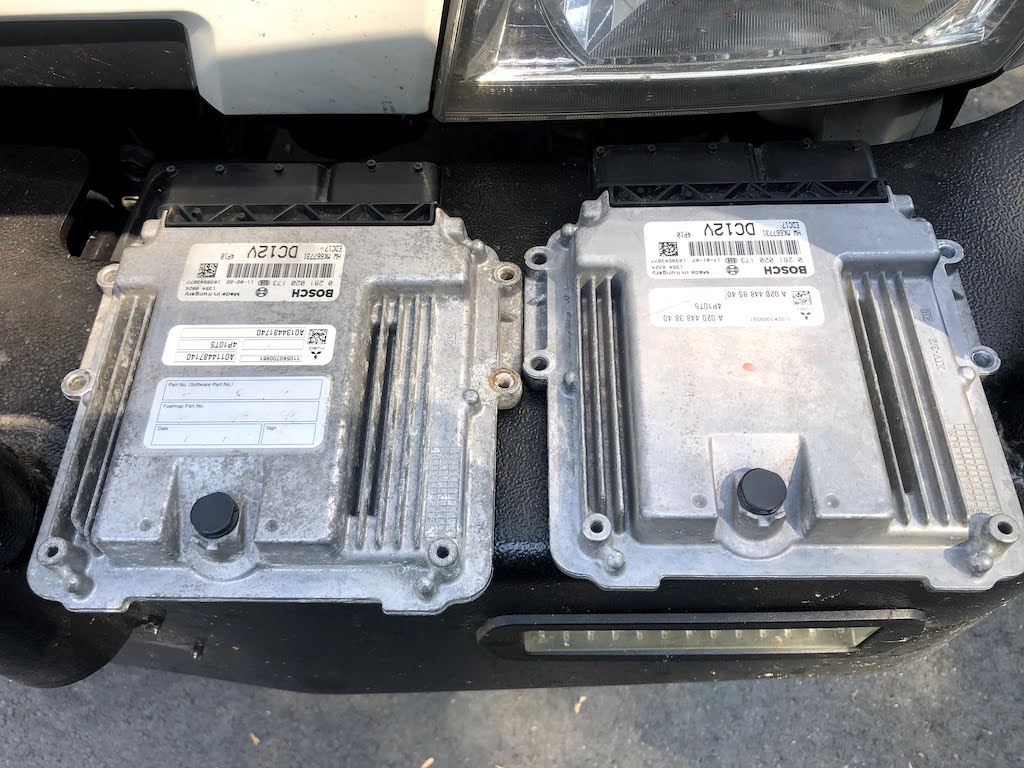Molly is a great truck, but she was never designed to run at high altitude and with lower quality diesel, both conditions found in South America. So, in preparation for our journey South, we prepared a second ECU.
An ECU, or Engine Control Unit, is the computer inside Molly that controls the engine management functions of the truck. The software inside the ECU can be modified or tuned to better handle high altitude and lower quality diesel. Since most of South America has low quality diesel, there are less trucks with modern diesel exhaust treatment systems and consequentially less places that sell DEF (Diesel Exhaust Fluid). The modified software also deletes the need for DEF.
So now we have two ECUs. The second one is for certain parts of South America, and the original one for the rest of the world. The idea is that we will replace the original ECU that came with the truck with the second one, once we are in South America as needed. The second ECU also acts as a spare, in the very unlikely event the original ECU fails. While in North America, we will always use the original ECU, as it has lower NOx emissions, which is better for the environment.
Is it legal to modify Molly? California Vehicle Code Section 27156 and the Federal Clean Air Act prohibit modifications that increase motor vehicle emissions. In the USA, it is clearly not legal to modify the emissions systems. As mentioned above, while driving in the USA, both on highway and off, Molly has all of the original and unmodified factory emissions equipment.
Another possible modification for people heading to South America is to remove the DPF or Diesel Particulate Filter. The DPF can get clogged with the extra particulates present in the diesel sold in South America. We choose to leave the DPF filter in place and rely on the engine’s DPF re-generation cycles, to keep the filter clean and working. Although it should be mentioned that there are numerous stories in the overloading community of modern diesel trucks being stranded in the middle of nowhere because of a clogged DPF. We will continue to keep an eye on the overloading forums, and those that have taken FUSO and Iveco trucks to South America, and learn from their experiences.
South America is improving the quality of the diesel being sold every year, and second ECU preparation might not be needed. There is more information on the state of ULSD (Ultra Low Sulfur Diesel) in South America, in our write-up here.
Ultimately the goal is to protect the environment, and make as few modifications to the truck as possible. So we will operate Molly using the original factory issued ECU whenever we can, but high on the Altiplano in Bolivia, we might be forced to use the second ECU specifically tuned for South America. I guess we will find out in the future. Fingers crossed, we will never need to use it.


More Information
Tucks Truck has travelled extensively through South America with an Iveco Daily which uses the Iveco F1C engine. The F1C engine is essentially the same engine as the 4P10T5 engine that is in our FUSO powering Molly. There is one big difference, Molly’s engine is a more modern variant and introduces the DEF dosing and Selective Catalytic Reduction (SCR) stage, taking it from Euro V to Euro VI compliant. Tuck’s truck has an excellent write-up on their recommendations here, and you can see that they were also worried about clogging their DPF. Ultimately however they made it around South America without having any significant issues and recommend not changing the emission system. They acknowledge that extended use of high sulfur diesel at high altitude is likely to cause issues. Their detailed write-ups are very educational and encouraging.
The DPF in Molly is designed to remove the particulate matter (aka soot), which according to the World Health Organization is a cause of cancer. It is a personal decision, but our choice is not to remove the DPF. A growing number of Overlanders travelling along the Pan American Highway report that that modern DPF systems are able to handle diesel with sulfur content up-to 500 ppm. It is also recommended to use engine oil with low SAPS (Sulphated Ash, Phosphorus and Sulphur), to reduce the the chance of the DPF getting clogged.
